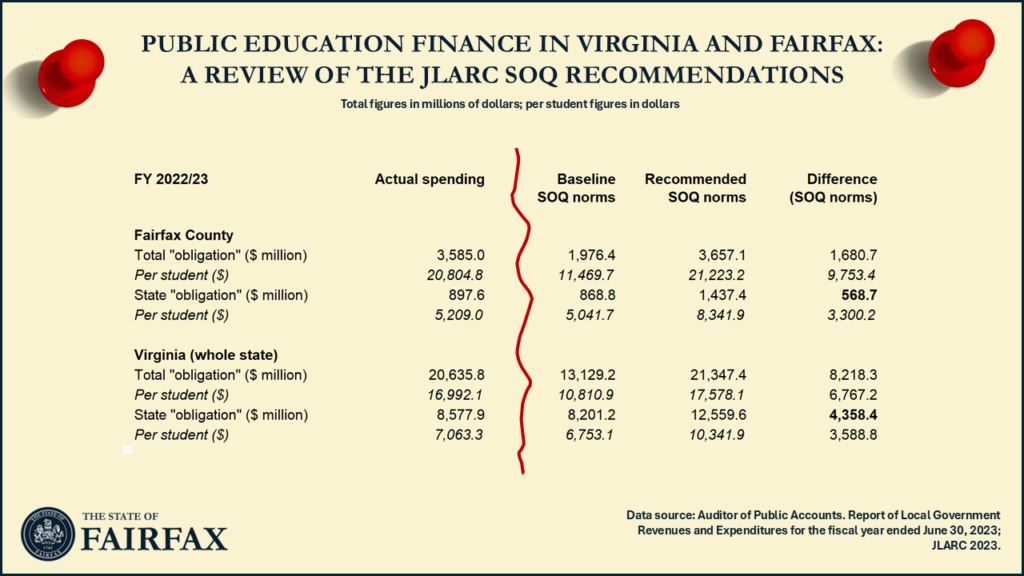The Fairfax County Public School system is lobbying for greater funding for the school system, claiming that the Fairfax County Board of Supervisors advertised budget underfunds FCPS by $150 million. Its brochure claims that “[f]or decades, the Commonwealth has underfunded public schools — for FCPS alone this underfunding amounts to $568.7 million each year or the equivalent of $3,100 per pupil.”
FCPS further claims that it “cannot cut its budget anymore without impacting the classroom experience”, and that “FCPS cannot continue to sustain excellence with ongoing underfunding and budget cuts”. They even prepared a snazzy video to promote its cause—arguing that school excellence in Fairfax County is at a crossroads.
These are strong words, but are they true?
Are Fairfax County Public Schools being underfunded by $568.7 million?
The first question that should urgently be answered is whether Fairfax County Public Schools actually being underfunded to the tune of 567 million dollars. The objective answer to this question is: No.
The most important maxim in economics is that while human wants and needs are limitless, resources are scarce. This means that according to the dismal science, in theory, every single human want and need is underfunded. To make a policy assertion that a government program is being underfunded, one must show the gap between the funding that is available and the funded that is needed, based on a clear funding standard.
When FCPS claims that the school system is being underfunded, it points to a state-wide study performed in 2023 performed by Joint Legislative Audit and Review Commission (JLARC) that suggests that the public education funding norms being used by the state—called Standards of Quality (SOQ)—are much lower than what the Commission deems reasonable. The report itself does not talk of underfunding —which would imply that funding is less than a sound funding norm. Instead, the report talks about the fact that the SOQ norms underestimate the needs of school divisions in the commonwealth. JLARC’s summary states that:
“The SOQ formula is intended to calculate the funds needed to provide a high quality education, but SOQ total funding is well below actual school division expenditures. The SOQ formula calculated school divisions needed a total of $10.7 billion in state and local funding for FY21, but divisions actually spent $17.3 billion on K–12 operations, $6.6 billion more than the funding formula indicated was needed.”
Policy statements and media reports containing versions of the phrase that a “2023 JLARC analysis found that FCPS is underfunded by $568.7 million” are not new, but not everyone has the public finance background to review the detailed annexes of the JLARC report and to interpret what the report actually says.
The good news is that the underlying JLARC estimates actually mention the number $568.7 million ($568,683,000) for Fairfax. But this number does not refer to the gap between actual FCPS needs and actual FCPS funding. Instead, the number $568.7 million refers to the difference between the state SOQ funding obligation change under the current SOQ norms and the SOQ norms recommended by the Commission.
Based on the JLARC report’s estimates, it is possible to calculate the difference between the FCPS funding needs (based on the SOQ norms recommended by JLARC) and the actual level of FCPS funding. JLARC’s total (state plus local) funding recommendation (based on FY2023 figures) for Fairfax County is 3.66 billion dollars.
This is spending level is almost exactly equal to the FCPS School Operating Fund of $3.7 billion for the current budget year (FY2025). In other words, while the county government and the commonwealth may disagree about how much each should contribute to public education in Fairfax County based on the JLARC study, FCPS is actually not being underfunded at all: the “shortfall” in state funding is fully covered by the county government instead.
While it would be a good idea to fix the SOQ norms, since Fairfax County does not get its fair share of money from the commonwealth for public education, it is simply nonsense to say that FCPS is being underfunded to the tune of 568 million dollars. At best, one could argue that the Fairfax County government or the taxpayers of Fairfax County are being underfunded by 568 million dollars, but the school division is not.[1]
Is the Fairfax County Public Schools budget actually at risk of being cut?
Another argument made by FCPS leaders is that Fairfax County’s advertised budget “underfunds” FCPS by $150 million, and that FCPS is facing budget cuts.
Is the Fairfax County Public Schools budget actually at risk of being cut? Again, the short answer is “No”. Both the county government’s budget as well as the FCPS budget are projected to increase by hundreds of millions of dollars for the coming year.
Although the leaders of both the county government and the school system are pretending that they are facing budget cuts in the coming budget cycle, in reality, they are simply trying to reduce spending on lower-priority items, and shifting resources towards higher-priority programs.
For instance, the Fairfax County’s Board of Supervisors is considering cuts to specific spending programs, including the elimination of the Middle School After School Program, which would save the county’s Department of Neighborhood and Community Services 3.9 million dollars. This cut is being proposed not because revenues are shrinking (they are not), but so that more money can be spent on other programs (e.g., salary increases). For instance, the county is planning for $123.60 million in proposed increases in county compensation (i.e., salary increases). Given that after-school programs are popular among residents, cutting spending on these county services would be ill-advised.[2]
At the same time, Fairfax County’s proposed (or advertised) budget contains a robust increase of $118.64 million dollars in school funding from the county budget for the coming year. As such, the FCPS budget is not being cut: the FCPS budget is growing, and the county’s contribution is increasing.
The argument made by FCPS that Fairfax County is “underfunding” the school division by $150 million is based on the fact that the county is not planning to fully fund the school division’s requested budget increase of $297.1 million dollars, most of which ($212.4 million) is earmarked for increased teacher salaries (“compensation adjustments” of 7%). The County Executive’s Message gives a detailed explanation why he cannot recommend fully funding the FCPS request.
It is worth noting that the requested salary increases being considered (both by the county itself as well as by the school system) are well above the average salary increases of public and private sector workers over the past 12 months.
The labor market trends over the past 12 months—or the county’s economic projections contained in the advertised budget—do not take into account the recent economic instability and the decimation of the federal workforce that is disproportionately impacting Fairfax County’s residents and the county’s economy. Thus, in spite of the fact that the country is at the precipice of a recession, FCPS is being offered an increase in funding to fund partial pay increases in teacher salaries, some of which would be funded by an increase in the property tax rate on the county’s residents.
Concluding thoughts
It is understandable that FCPS wants to advocate for greater funding for public schools, and that it wants its teachers to get better compensation. Teaching is a hard job, and teachers deserve to be respected and paid as professionals. And good public schools are important to our local community and our local economy.
Fairfax County Public Schools defines excellence as “striving for the highest standards of performance, quality, and achievement for all students”. FCPS also expects its students to be honest and forthright, and to consistently pursue academic integrity. The residents of Fairfax County deserve that FCPS leadership holds itself to the same standards.
Spreading half-truths, however, falls short from this standard of excellence and integrity. It is disingenuous to claim that “FCPS cannot continue to sustain excellence with ongoing underfunding and budget cuts”. FCPS is not being underfunded and it is not being subjected to budget cuts. The only threat to the FCPS budget is that teachers may not get as big of a salary increase as they had hoped for during the coming year, as the entire country braces for difficult economic times ahead.
FCPS officials should know that playing with semantics is not excellence. It is disingenuous. It is harmful to public trust. And it falls short of the standard of excellence to which they hold their own students and teachers. So yes, excellence at FCPS is at a crossroads.
[1] As I argued elsewhere, raising the SOQ standards would not necessarily result in greater education spending, but would most likely result in a reduction in local spending on education funded by local taxes—in Fairfax County, but especially, in other (already low-tax) counties.
[2] A cynic might argue that this is exactly why the Department of Neighborhood and Community Services proposed eliminating this program.



